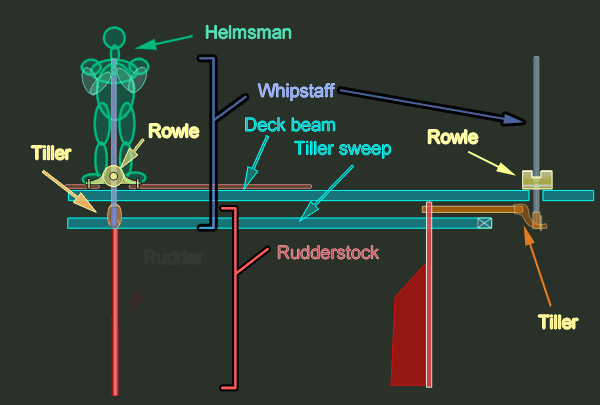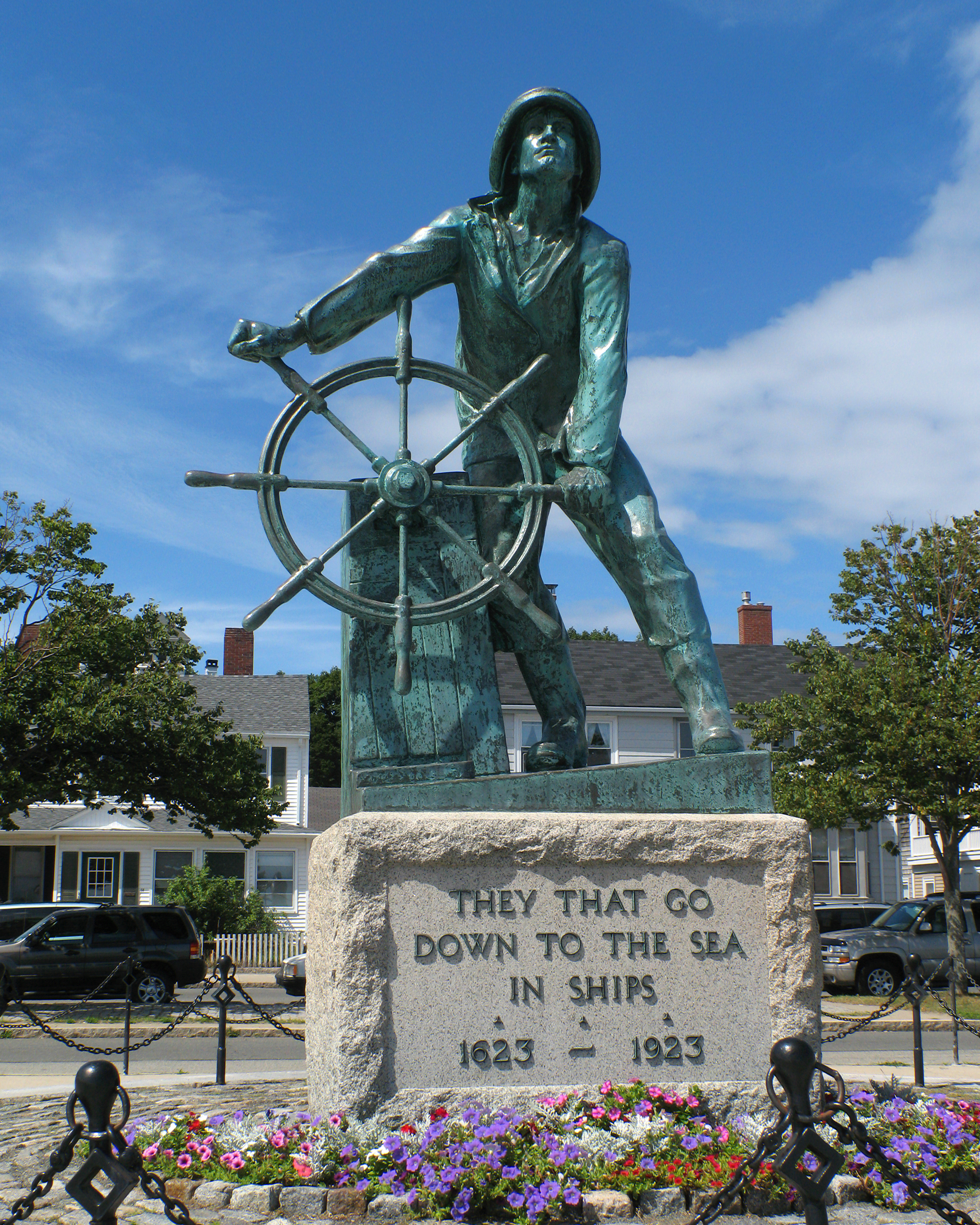|
Relieving Tackle
Relieving tackle is tackle employing one or more lines attached to a vessel's steering mechanism, to assist or substitute for the whipstaff or ship's wheel in steering the craft. This enabled the helmsman to maintain control in heavy weather, when the rudder is under more stress and requires greater effort to handle, and also to steer the vessel were the helm damaged or destroyed. In vessels with whipstaffs (long vertical poles extending above deck, acting as a lever to move the tiller below deck), relieving lines were attached to the tiller or directly to the whipstaff. When wheels were introduced, their greater mechanical advantage lessened the need for such assistance, but relieving tackle could still be used on the tiller, located on a deck underneath the wheel.McGowan, Alan, ''The Century before Steam, 1700–1820'', Volume 4 of ''The Ship'', pp. 15–16. HM Stationery Office The Office of Public Sector Information (OPSI) is the body responsible for the operation of His ... [...More Info...] [...Related Items...] OR: [Wikipedia] [Google] [Baidu] |
Block And Tackle
A block and tackle or only tackle is a system of two or more pulleys with a rope or cable threaded between them, usually used to lift heavy loads. The pulleys are assembled to form blocks and then blocks are paired so that one is fixed and one moves with the load. The rope is threaded through the pulleys to provide mechanical advantage that amplifies the force applied to the rope. Hero of Alexandria described cranes formed from assemblies of pulleys in the first century. Illustrated versions of Hero's ''Mechanica'' (a book on raising heavy weights) show early block and tackle systems. Overview A block is a set of pulleys or sheaves mounted on a single frame. An assembly of blocks with a rope threaded through the pulleys is called tackle. The process of threading ropes or cables through blocks is called "reeving", and a threaded block and tackle is said to have been "rove". A block and tackle system amplifies the tension force in the rope to lift heavy loads. They are common ... [...More Info...] [...Related Items...] OR: [Wikipedia] [Google] [Baidu] |
Whipstaff
A whipstaff, sometimes called a whip, is a steering device that was used on 16th- and 17th-century European sailing ships. Its development preceded the invention of the more complex ship's wheel and followed the simple use of a tiller to control the steering of a ship underway. Before the 16th century, most sailing vessels were sufficiently small that they could be steered by a single individual working the handle of the tiller, which was directly connected to the rudder stock and therefore the rudder A rudder is a primary control surface used to steer a ship, boat, submarine, hovercraft, aircraft, or other vehicle that moves through a fluid medium (generally air or water). On an aircraft the rudder is used primarily to counter adve .... However, as ships became taller and broader, there came a need for a steering device which could stretch from the top deck of the stern down to the tiller, which was sometimes located more than a deck below. The whipstaff became th ... [...More Info...] [...Related Items...] OR: [Wikipedia] [Google] [Baidu] |
Steering Wheel (ship)
A ship's wheel or boat's wheel is a device used aboard a water vessel to steer that vessel and control its course. Together with the rest of the steering mechanism, it forms part of the helm. It is connected to a mechanical, electric servo, or hydraulic system which alters the horizontal angle of the vessel's rudder relative to its hull. In some modern ships the wheel is replaced with a simple toggle that remotely controls an electro-mechanical or electro-hydraulic drive for the rudder, with a rudder position indicator presenting feedback to the helmsman. History Until the invention of the ship's wheel, the helmsman relied on a tiller—a horizontal bar fitted directly to the top of the rudder post—or a whipstaff—a vertical stick acting on the arm of the ship's tiller. Near the start of the 18th century, a large number of vessels appeared using the ship's wheel design, but historians are unclear when the approach was first used. Design A traditional ship's wheel is compos ... [...More Info...] [...Related Items...] OR: [Wikipedia] [Google] [Baidu] |
Helmsman
A helmsman or helm (sometimes driver) is a person who steering, steers a ship, sailboat, submarine, other type of maritime vessel, or spacecraft. The rank and seniority of the helmsman may vary: on small vessels such as fishing vessels and yachts, the functions of the helmsman are combined with that of the skipper (boating), skipper; on larger vessels, there is a separate officer of the watch who is responsible for the safe navigation of the ship and gives orders to the helmsman, who physically steers the ship in accordance with those orders. In the merchant navy, the person at the Ship's wheel, helm is usually an able seaman, particularly during ship arrivals, departures, and while maneuvering in restricted waters or other conditions requiring precise steering. An ordinary seaman is commonly restricted to steering in open waters. Moreover, military ships may have a Seaman (rank), seaman or quartermaster at the helm. A professional helmsman maintains a steady course, properly ex ... [...More Info...] [...Related Items...] OR: [Wikipedia] [Google] [Baidu] |
Tiller
A tiller or till is a lever used to steer a vehicle. The mechanism is primarily used in watercraft, where it is attached to an outboard motor, rudder post or stock to provide leverage in the form of torque for the helmsman to turn the rudder. A tiller may also be used in vehicles outside of water, and was seen in early automobiles. On vessels, a tiller can be used by the helmsman directly pulling or pushing it, but it may also be moved remotely using tiller lines or a ship's wheel. Rapid or excessive movement of the tiller results in an increase in drag and will result in braking or slowing the boat. Description A tiller is a lever used to steer a vehicle. It provides leverage in the form of torque to turn the device that changes the direction of the vehicle, such as a rudder on a watercraft or the surface wheels on a wheeled vehicle. A tiller can be used by directly pulling or pushing it, but it may also be moved remotely using tiller lines or a ship's wheel; some kayaks wh ... [...More Info...] [...Related Items...] OR: [Wikipedia] [Google] [Baidu] |
Mechanical Advantage
Mechanical advantage is a measure of the force amplification achieved by using a tool, mechanical device or machine system. The device trades off input forces against movement to obtain a desired amplification in the output force. The model for this is the ''law of the lever.'' Machine components designed to manage forces and movement in this way are called mechanisms. An ideal mechanism transmits power without adding to or subtracting from it. This means the ideal machine does not include a power source, is frictionless, and is constructed from rigid bodies that do not deflect or wear. The performance of a real system relative to this ideal is expressed in terms of efficiency factors that take into account departures from the ideal. Lever The lever is a movable bar that pivots on a fulcrum attached to or positioned on or across a fixed point. The lever operates by applying forces at different distances from the fulcrum, or pivot. The location of the fulcrum determines ... [...More Info...] [...Related Items...] OR: [Wikipedia] [Google] [Baidu] |
Her Majesty's Stationery Office
The Office of Public Sector Information (OPSI) is the body responsible for the operation of His Majesty's Stationery Office (HMSO) and of other public information services of the United Kingdom. The OPSI is part of the National Archives of the United Kingdom and is responsible for Crown copyright. The OPSI announced on 21 June 2006 that it was merging with the National Archives. The merger took place in October 2006. The OPSI continues to discharge its roles and responsibilities from within the structure of the National Archives. Controller of HMSO and Director of OPSI The Controller of HMSO is also the Director of OPSI. HMSO continues to operate from within the expanded remit of OPSI. The Controller of HMSO also holds the offices of Kings's Printer of Acts of Parliament, King's Printer for Scotland and Government Printer for Northern Ireland. By virtue of holding these offices OPSI publishes, through HMSO, the ''London Gazette'', ''Edinburgh Gazette'', ''Belfast Gazette'' a ... [...More Info...] [...Related Items...] OR: [Wikipedia] [Google] [Baidu] |
Careening
Careening (also known as "heaving down") is a method of gaining access to the hull of a sailing vessel without the use of a dry dock. It is used for cleaning or repairing the hull. Before ship's hulls were protected from marine growth by fastening copper sheets over the surface of the hull, fouling by this growth would seriously affect the sailing qualities of a ship, causing a large amount of drag. Practice The vessel is grounded broadside onto a steep beach and then pulled over with tackles from the mastheads to strong points on the beach. This brings one side of the hull out of the water. Careening may be assisted by moving ballast to one side of the hull. When work was complete on one side, the ship would be floated off and the process repeated on the other side. A beach favoured for careening was called a careenage. Today, only small vessels are careened, while large vessels are placed in dry dock. A related practice was a Parliamentary heel, in which the vessel was heele ... [...More Info...] [...Related Items...] OR: [Wikipedia] [Google] [Baidu] |
Ships
A ship is a large watercraft that travels the world's oceans and other sufficiently deep waterways, carrying cargo or passengers, or in support of specialized missions, such as defense, research, and fishing. Ships are generally distinguished from boats, based on size, shape, load capacity, and purpose. Ships have supported exploration, trade, warfare, migration, colonization, and science. After the 15th century, new crops that had come from and to the Americas via the European seafarers significantly contributed to world population growth. Ship transport is responsible for the largest portion of world commerce. The word ''ship'' has meant, depending on the era and the context, either just a large vessel or specifically a ship-rigged sailing ship with three or more masts, each of which is square-rigged. As of 2016, there were more than 49,000 merchant ships, totaling almost 1.8 billion dead weight tons. Of these 28% were oil tankers, 43% were bulk carriers, and 13% were cont ... [...More Info...] [...Related Items...] OR: [Wikipedia] [Google] [Baidu] |




